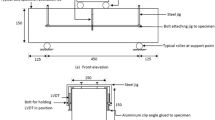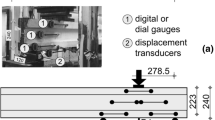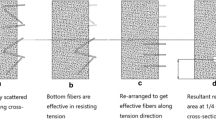Abstract
The flexural performance of steel fibre-reinforced beams with varying amounts and types of fibre is evaluated in terms of toughness parameters and residual strength factors determined in accordance with ASTM Standard C1018-89. Five types of steel fibre in amounts from 30 to 105 kg m−3, and two matrix strength levels, were examined in a program of 117 tests using beams 150 mm wide and 100 mm deep loaded at the third points over a 750 mm span. Significant differences in performance associated with changes in matrix and fibre parameters are clearly identified in this test. First-crack strength depends mainly on characteristics that govern matrix strength and is minimally dependent on fibre parameters such as type, size and amount. Toughness indices and residual strength factors, particularly those corresponding to higher deflections, depend primarily on fibre type, amount and, for geometrically similar fibres, aspect ratio. All are minimally dependent on matrix strength.
Resume
On évalue la performance en flexion de poutres renforcées de fibres d'acier de différents types et dans des quantités différentes, suivant des paramètres de résilience et des facteurs de résistance résiduelle définis selon la norme ASTM C1018-89. On a examiné cinq types de fibres d'acier dans des proportions allant de 30 à 150 kg m−3, et deux ordres de résistance de matrice, dans un programme de 117 essais sur des poutres larges de 150 mm et épaisses de 100 mm chargées en trois points sur une portée de 750 mm.
On a nettement identifié des différences significatives de performance en liaison avec des variations de paramètres de la matrice et des fibres. La résistance à la fissuration initiale dépend essentiellement des caractéristiques qui gouvernent la résistance de la matrice, et minimalement des paramètres de fibre, tels le type, la dimension et la proportion. Les indices de résilience et les facteurs de résistance résiduelle, en particulier ceux qui correspondent aux flexions les plus fortes, dépendent principalement du type et de la proportion de fibre et, pour des fibres de géométrie similaire, des quantités relatives. Tous dépendent minimalement de la résistance de la matrice.
Similar content being viewed by others
References
ASTM ‘Standard test method for flexural toughness and first-crack strength of fiber-reinforced concrete”, Designation C1018-89, ASTM Book of Standards, Vol. 04.02 (1989).
Johnston, C. D., ‘Toughness of steel fiber reinforced concrete’, in ‘Steel Fibre Concrete’, US-Sweden joint seminar, Swedish Cement and Concrete Institute, Stockholm, edited by S. P. Shah and Å. Skarendahl (Elsevier Applied Science, London, 1986) pp. 333–360.
Idem, ‘Definition and measurement of flexural toughness parameters for fiber reinforced concrete’,Cement Concr. Aggreg.4(2) (1982) 61–67.
Johnston, C. D. and Gray, R. J., ‘Flexural toughness and first-crack strength of fibre-reinforced concrete using ASTM Standard C1018’, in Proceedings of 3rd International RILEM Symposium on Developments in Fibre Reinforced Cement and Concrete, Sheffield, July 1986, Paper 5.1.
Johnston, C. D. and Carter, P. D., ‘Fiber-reinforced concrete and shotcrete for repair and restoration of highway bridges in Alberta’, in Proceedings of International Symposium on Recent Developments in Concrete Fiber Composites, US Transportation Research Board, TRB Record No. 1226 (1989) pp. 7–16.
Swedish Standard SS 13 72 12, ‘Concrete Testing—Hardened Concrete—Flexural Strength’.
Swedish Standard SS 13 72 10 ‘Concrete Testing—Hardened Concrete—Cube Strength’.
Johnston, C. D., ‘Effects of flexural performance of sawing plain concrete and sawing and other methods of altering the degree of fibre alignment in fiber-reinforced concrete’,Cement Concr. Aggreg. 11(1) (1989) 23–29.
Author information
Authors and Affiliations
Rights and permissions
About this article
Cite this article
Johnston, C.D., Skarendahl, Å. Comparative flexural performance evaluation of steel fibre-reinforced concretes acoording to ASTM C1018 shows importance of fibre parameters. Materials and Structures 25, 191–200 (1992). https://doi.org/10.1007/BF02473063
Issue Date:
DOI: https://doi.org/10.1007/BF02473063




